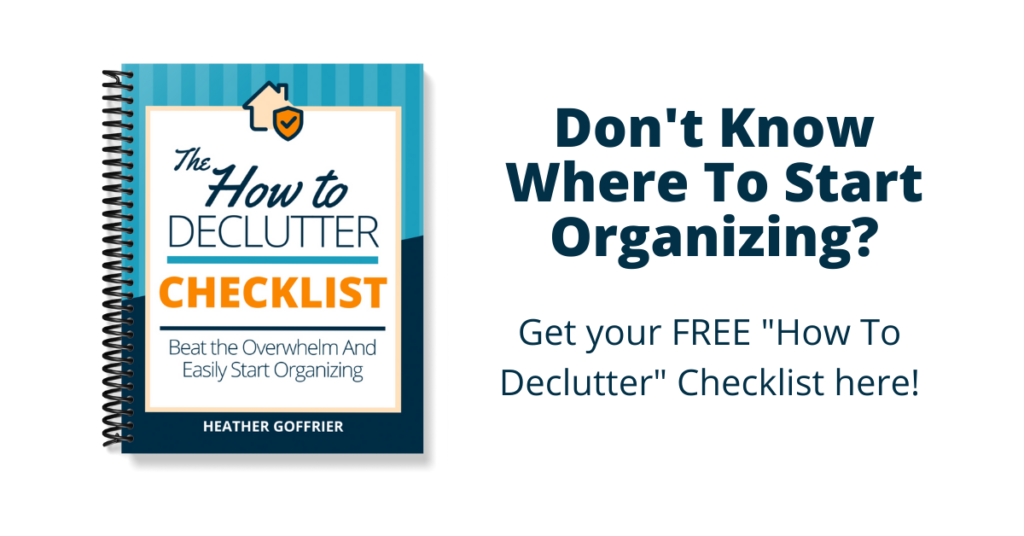When you struggle getting newborn to sleep, you miss your own rest and time to get stuff done. Discover 17 hacks to help baby sleep and give you a break! Plus, get your free “How To Declutter” Checklist to get your baby stuff organized. Click this button to download:
This is the fourth post in my “Newborn Sleep” Series. Be sure to check out the other posts in the series!

I remember one night I had the hardest time getting my newborn to sleep.
I had tried everything I could think of to soothe her, and I was exhausted. She had eaten, she was tired, and she had a clean diaper. I was ready to give up trying, and I felt like a failure.
Why won’t this baby stop crying?!?!
After going down the list of everything I could think of, I decided to look at her more closely to see if I could find anything wrong. As I searched, I finally found the reason for her distress:
My baby had one of my long hairs wrapped between her fingers. I don’t know why it bugged her so much, but once I removed it, she went happily to sleep.
Babies are a mystery, and sometimes they cry for no reason. However, often they have a reason for their complaining, and it’s up to us as moms to figure it out.
And a new mom, you might not know that you have a ton of resources, hacks, and tools available to help you troubleshoot what’s keeping your baby awake.
Here’s a list of tips to help you get your infant to sleep, so you can get some sleep as well!
Table of Contents
17 Insanely Powerful Tips For Getting Newborn To Sleep At Night
1- Infant Fighting Sleep? Check For Something Bothering Baby
Sometimes babies just cry. But often there is something legit bothering them, and it’s up to us moms to sleuth it out.
We hope you enjoy the products we recommend! This post contains affiliate links. Please see our full disclosure policy here.
Start by checking:
- Is baby’s crib under a vent and they don’t like air blowing on them?
- Are they too cold and need another layer or sleep sack?
- Is baby too hot and needs you to take off a layer or adjust room temperature?
- Are they not feeling well or have a fever?
- Wet diaper?
- Piece of hair in their pjs, mouth or stuck between their toes or fingers?
- Is something stuck inside their footie pajamas that you didn’t see in the laundry.
- Do they need to burp?
- Fingers or toes stuck in a weird position inside clothing?
- Did a sleep sack rotate around or get stuck underneath them so they can’t kick their feet?
- Swaddling baby at night? Maybe the swaddle came loose or is too tight.
2- Create A Bedtime Routine
I know that since newborns sleep all the time, it’s hard to feel like they have a “bedtime.”
But it’s good to start carving out the time in your mind that you’d like their bedtime to be, even if you get them up for a dream feed and they wake during the night.
Carry out baby’s nightly routine in the same order each time.
For example:
- Bath time
- diaper
- lotion
- pjs
- sing a song
- *nursing/bottle
- snuggle until almost asleep
- then gently set in bed
*If you’re using a Dream feed in the later evening and you just fed baby recently, put them to down to bed before another feed. Then get up for the dream feed.
RELATED: 21 TOP BABY SLEEPING PRODUCTS TO KEEP BABY SNUG, SAFE AND ASLEEP ALL NIGHT
3- Getting Newborn To Sleep With A Bathtime Before Bed
A regular bath time before bed can be a soothing part of the bedtime routine. We actually didn’t do nightly baths, but I know many moms who loved including it as part of the routine.
We gave baths 1-3 times per week, but if baby was especially fussy we would be sure to include bath time.
Baths can have a calming affect on babies, and as their body temperature gradually cools after bath time, it can naturally help them drift off (as long as they’re not getting TOO cold!).
One reason we didn’t bathe every night is that our kids are prone to dry skin and eczema, and bathing too often can dry a baby’s skin out. However, every baby is different, so take some time and observation to discover what works best for your baby and your family.
4- Watch Baby For Sleep Cues
Babies give clues to when they’re ready to sleep, and they aren’t always what you think. In fact, sometimes it will seem like your baby is wide awake and ready to party, but if you lay them down for a nap they’ll go right to sleep.
Learning sleep cues is a must for every mom because it will help you know exactly when to get baby down for a nap.
You may have been looking for ways to help baby sleep when what you actually need to know is when to put them down.
You may have been looking for ways to help baby sleep when what you actually need to know is when to put them down. #newbornsleeptips #babysleep Share on XHere are some examples of sleep cues:
- Yawning
- Rubbing eyes
- Wide-eyed stare
- Getting fussy
- Avoiding eye contact
- Acting quieter and more calm
Click here for a complete list of newborn sleep cues.
One thing I learned from the book “Secrets Of The Baby Whisperer” is to put baby down by the third yawn. Or you could say, once you’ve seen three sleep cues they should already be in bed.
RELATED: EVERY MOM WHOSE NEWBORN SLEEPS WELL KNOWS THESE 15 NEWBORN SLEEP CUES
5- Choose Soft Bedding That Doesn’t Chafe
When we had our first daughter, my sister in law gave me some great advice about crib bedding. She said that as cute as some patterns and nursery decor can be, some of those materials can be hard on baby’s skin.
Over time, those cute but low quality fabrics can be like an annoying tag on the back of your shirt– itchy, irritating and maybe even causing a rash.
Instead, she recommended chenille for all crib bedding, which can help prevent baby’s face from getting red and raw from a low quality material.
I took her advice, and I’ve been very happy that my babies’ faces stayed soft and healthy, and they didn’t have sleep issues because of any chafing on their skin.
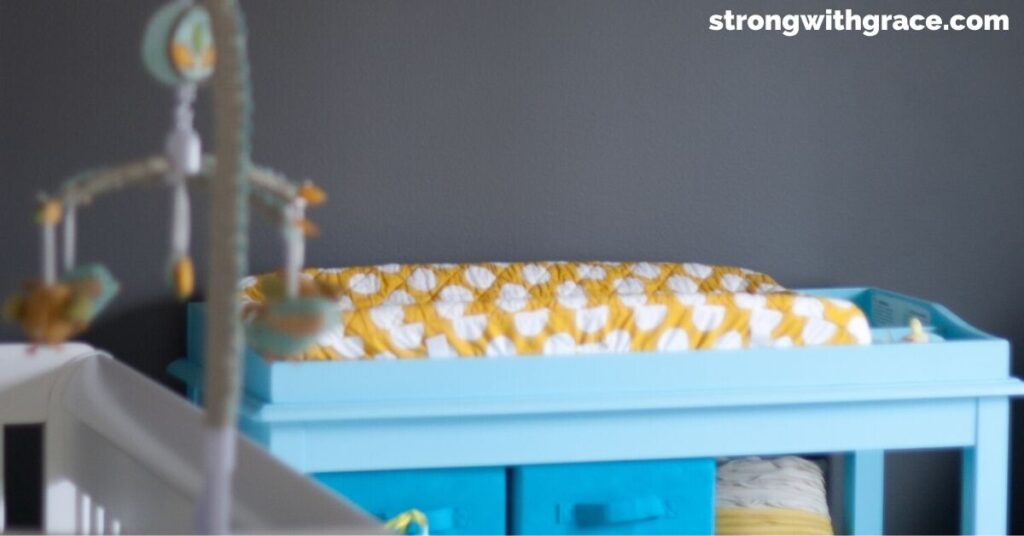
6- A Night Light
When my kids were babies they didn’t need a nightlight. But as they got older (around 18 months) they seemed to like having a light in their rooms.
Deciding to give them a nightlight wasn’t an exact science.
On a night they were particularly fussy, we thought, “Hmmm maybe they’d like some light.” When we plugged it in and they seemed to sleep better, we kept it ever since.
Parenting is a lot of trial and error: you try things and figure out what works and what doesn’t. It takes time and a bit of frustration sometimes, but you will learn a ton about your child in the process.
But I will say that having a nightlight has helped my kiddos settle down in their rooms, so it’s worth a shot if you don’t already use one
When your kids get older you might want a cute decorative or character nightlight. But in the early stages, one with an on/off switch is really handy. Then you can pop it on for the diaper change and to get situated for a feed. If you have a soft light bulb, it will light the room without overstimulating baby.
7- To Diaper Change, or Not?
When feeding baby at night, one thing to test is whether or not you need to change baby’s diaper.
I would have loved to skip the diaper change, and many moms swear that avoiding it helps their babies go right back to sleep.
But my babies were pee-machines, and they hated being wet. So I ended up changing them every time.
In my experience, changing their diapers at night didn’t prevent my kids from falling right back to sleep. I think the daily routine we used throughout the day and night gave them a predictable schedule and ability to head right back to lala land.
You might be able to get away with not changing it, so it’s something to try out.
8- Should you sing a lullaby or play music?
Baby loves to hear your voice, so of course you can sing to baby. However, just be sure to sing at a soft, low level and sing a soothing melody.
If you start rocking out at bedtime, baby will perk up and not be in the sleeping mood.
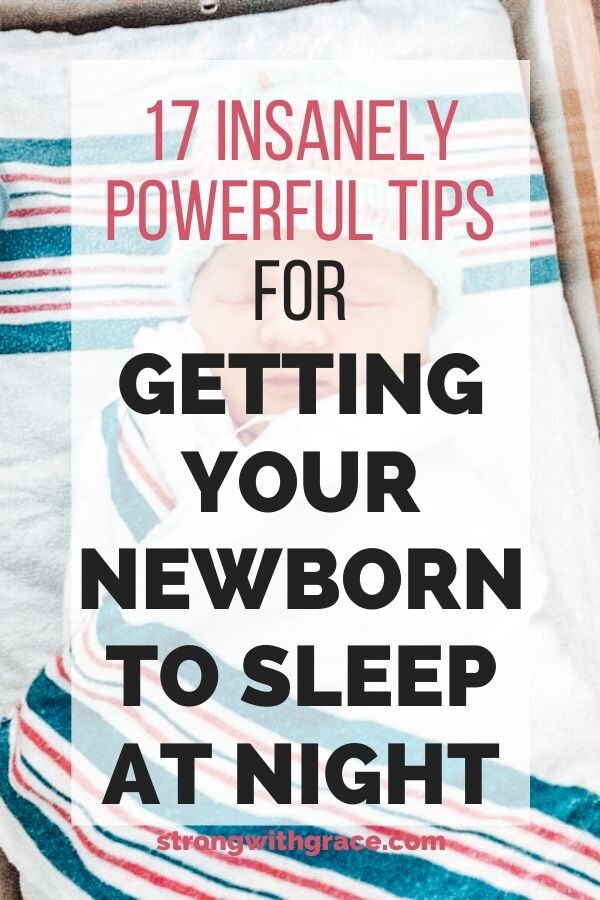
9- Minimize Talking To Baby In The Middle Of The Night
Along those lines, talking or singing to your baby in the middle of the night will perk up your child, which is the exact opposite of what you want at 3 am.
Your warm touch and snuggles will be enough to show your love, so don’t make too much noise or stimulate their senses if you want them to go back to sleep quickly.
Your warm touch and snuggles will be enough to show your love, so don't make too much noise or stimulate their senses if you want them to go back to sleep quickly. #newmom #infantsleep Share on X10- Use A White Noise Machine
We didn’t use a white noise machine until our third child, and looking back I wonder why? They are SO helpful for getting baby to sleep, and drowning out noises in the house that could keep your child awake.
I highly recommend them! We use this one.
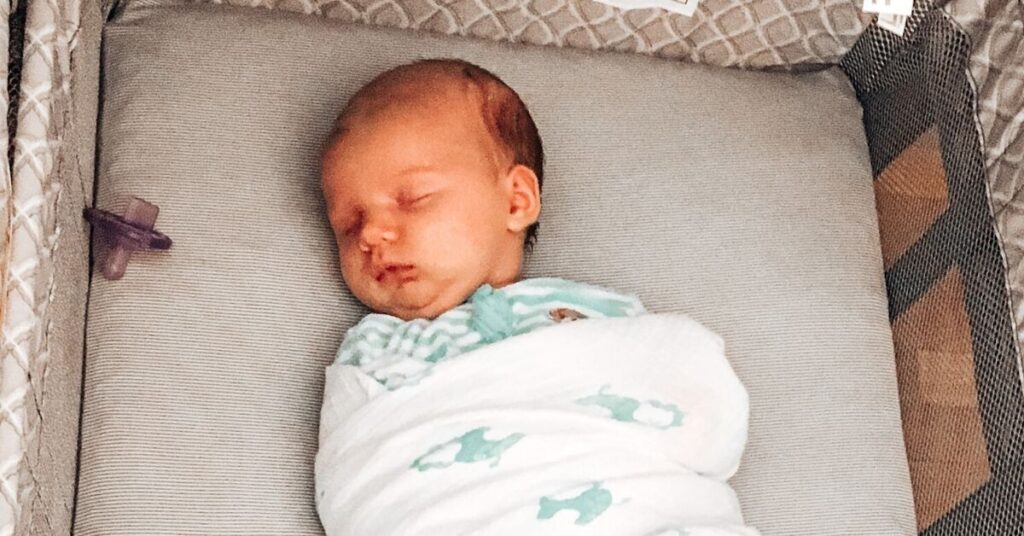
11- Try Blackout Curtains
Blackout curtains can help your baby fall asleep earlier and stay asleep longer, especially when you live where there’s a lot of light in the summer.
We live in the pacific northwest, and in the middle of summer it’s still light at 10pm or later. And let me tell you, neither me nor my husband want our kids up at 10pm.
That’s our time!
Hanging blackout curtains helps a baby’s body learn their circadian rhythms and get used to day vs. night. I hang them behind a set of thinner curtains so I don’t have to use them if I don’t need them.
For example, I don’t pull the blackout curtains during daytime naps.
This helps baby learn to sleep when there’s a bit of light. It also helps their body start to register that it’s not nighttime yet, so they learn to really zonk out at night (instead of having an all-night party that you have to attend).
If your newborn baby sleeps all day, then you have a problem! Make sure you wake them up to get regular feeds during the day so they sleep well at night.
12- Keep Lighting Dim
Along with blocking light from outside, you’ll want to keep the room lighting to a minimum at bedtime and during night feeds.
If you can turn on a night light instead of an overhead light, you won’t be overstimulating baby’s senses. Low lights can signal to baby that it’s sleepy time, which will help them fall asleep way easier!
Score!
13- Place A Microwaveable Heating Pad In Crib To Warm It
If your house runs cold or your baby tends to get cold, try heating up the crib with a microwaveable rice bag or heating pad.
As long as you remove it and check the crib to make sure it’s not too hot before putting baby down, a heating pad can help ease the transition from warm mom or dad to warm bed.
14- Create A Daily Routine For Better Baby Sleep
I see a lot of women jumping into sleep training without having any type of daytime schedule or even a bedtime routine.
But a good night sleep for baby starts with a consistent (but not rigid) daytime routine.
If you have predictable habits for when baby eats, plays (even if it’s just lying on a playmat), your baby will be primed and ready for nighttime sleep. So as counter-intuitive as it seems, before you jump into sleep training, be sure to have a solid daytime plan in place.
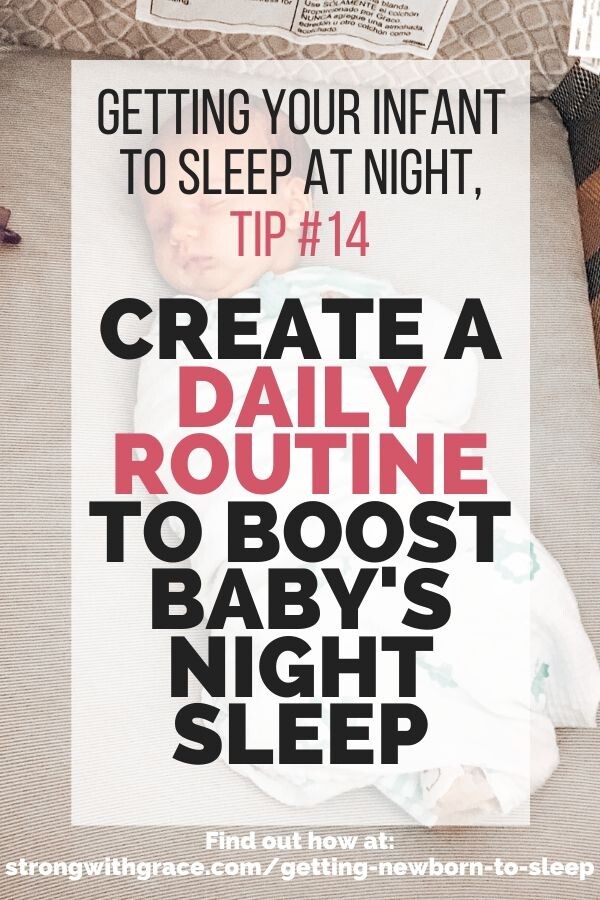
15- Upgrade Your Infant Sleep Training Plan
As I mentioned above, if you don’t have a daytime plan, or if you feel your current sleep training strategy is never going to work, it’s time to upgrade to a better plan.
16- The Pick up / Put down Method
The pick up/put down method can help baby get used to falling asleep on their own, while you’re still available and present to help calm them down.
How it works:
- If baby fusses when you put them down, you calmly pick them back up and snuggle them until they’re quiet.
- Wait until they’re drowsy and almost asleep (but not all the way out), then put them back down.
- Continue to pick up/ put down until they’re asleep in bed.
Yes, this method can take a while, but it’s worthwhile to help baby learn to fall asleep on their own while still reassuring them you’re there for them.
17- You’re NOT a Failure
You’re not a failure.
It takes time to get to know your baby and get into a routine. I know it’s frustrating when it feels like there’s nothing more you can do after the 1000 things you’ve tried. When you’re exhausted and spent and it’s the middle of the night, and why won’t they just go to sleep???
I have been there.
Every baby has their moments, no matter how good of a sleeper they may be. They may fight sleep, they will cry. Some of it is just babies being babies.
And some of it is a learning process as you get to know your baby and grow in your parenting skills.
Rest assured, you can do this and you will get through it.
And of course, some babies do have deeper issues like colic, feeding struggles, and other health issues that need attention. Don’t hesitate to contact your baby’s provider when your mom-gut tells you something is wrong!
Resources For Getting Newborn To Sleep:
The “Newborn Sleep” Series
This is the fourth post in my “Newborn Sleep” Series. Be sure to check out the other posts in the series and stay tuned for new additions!
- When Is The Best Time To Start An Infant Sleep Schedule?
- 5 Reasons To Start A Baby Sleep Schedule By 3 Weeks Old
- 7 Newborn Baby Schedule Mistakes To Avoid
- 17 Insanely Powerful Tips For Getting Newborn To Sleep At Night (This Post)
- Baby Never Sleeps? You Might Be Missing These 15 Newborn Sleep Cues
- How To Start A Newborn Sleep Schedule: 9 Expert Hacks +Free Download
- 13 Major Problems You May Face When NOT Using A Baby Sleep Routine
- Does It Work? How I Used A Newborn Sleep Routine With All My Girls
GRAB YOUR FREE “HOW TO DECLUTTER” CHECKLIST TO GET CONTROL OF ALL YOUR NEW BABY STUFF!

